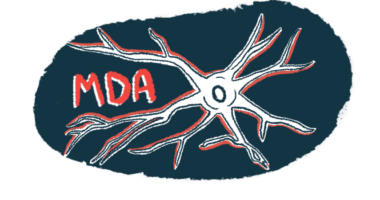Motor gains seen with Zolgensma, especially when given early
'Substantial evidence of improved outcomes' when administered in first months of life

The one-time gene therapy Zolgensma (onasemnogene abeparvovec-xioi) can improve motor outcomes for children with spinal muscular atrophy (SMA) effectively, especially when it’s given in the first months of life, a review paper shows.
“There is substantial evidence of improved outcomes when Zolgensma is administered early to children under [2] years of age,” the researchers wrote, noting Zolgensma has a manageable safety profile and is more cost-effective than other treatments.
“With the efficacy of this treatment option, physicians treating patients with SMA can be more confident in making an early diagnosis of SMA, which will improve the chances of survival and quality of life for their patients,” the scientists wrote in “Gene Therapy for Spinal Muscular Atrophy (SMA): A Review of Current Challenges and Safety Considerations for Onasemnogene Abeparvovec (Zolgensma),” which was published in Cureus.
SMA is caused by mutations in the SMN1 gene, which results in the gradual deterioration and death of motor neurons, the nerve cells that control movement.
Zolgensma is a gene therapy that delivers a healthy copy of the SMN1 gene to cells. It’s approved in the U.S. to treat patients 2 and younger.
Scientists from the Caribbean nation Saint Vincent and the Grenadines reviewed the published scientific literature for Zolgensma in SMA, noting that, in clinical trials that supported its approval, most babies with type 1 SMA treated with Zolgensma achieved motor function outcomes never seen among untreated patients with this severe SMA type.
The best outcomes were generally achieved when gene therapy was given as early as possible. Patients “given Zolgensma earlier in life (under 3 months, in particular) showed a quicker improvement in independent sitting and motor performance than later,” the researchers said. “Exploring the dosage timeline for this therapy can help us better understand the optimal time to provide it to patients.”
Side effects, cost-effectiveness of Zolgensma
Zolgensma also was generally well tolerated and researchers noted increases in liver enzymes (a sign of liver damage) as a common, but manageable side effect of treatment.
“With close monitoring of liver enzyme levels and the addition of prophylactic [preventive] medications, this adverse reaction can be easily managed while taking Zolgensma,” they wrote. “Practitioners should mitigate risk through appropriate monitoring and intervention.”
The researchers also noted that in studies with available data many children with increased liver damage markers after treatment had mildly high levels of these markers before Zolgensma.
“Further research must be done on the adverse effects on participants both with and without preexisting liver failure,” the researchers wrote. “In addition, it is important to explore safety and efficacy outcomes and observe whether they vary across social groups, such as gender and race.”
Zolgensma is also more cost-effective than other treatments, namely Spinraza (nusinersen) and Evrysdi (risdiplam), the researchers said.
They acknowledged Zolgensma carries the highest price tag — its list price is more than $2 million — but emphasized that it’s a one-time therapy, whereas Spinraza and Evrysdi must be taken regularly throughout a patient’s lifetime.
The researchers estimated the total cost of Zolgensma over a patient’s lifetime would be about $4.2 million, compared to a lifetime cost of $6.3 million for Spinraza.
“Critics of Zolgensma lament the cost of this therapy, but they only do so because of a shortsighted view … This is a one-time infusion that replaces the need for continuous treatment at intervals,” the researchers wrote. “Since the patient will not be injected multiple times as with other treatment plans, there is a reduced risk of infusion site-related infection or pain.”
Zolgensma’s approval was based on studies that tested an intravenous (into-the-bloodstream) formulation in young, small infants.
The clinical trial SMART trial (NCT04851873) is ongoing to assess the therapy in heavier children, who weigh 8.5-21 kgs (about 18-46 pounds), while STRONG (NCT03381729) and STEER trial (NCT05089656) are testing a formulation called OAV-101 that’s administered intrathecally, or by spinal injection.
“The range of patients who have access to Zolgensma is currently limited by age and weight due to the intravenous administration route. Future clinical trials testing the intrathecal route of delivery will potentially make Zolgensma available for older and heavier patients,” the researchers wrote.
Zolgensma is sold by Novartis, which wasn’t involved in this study.








